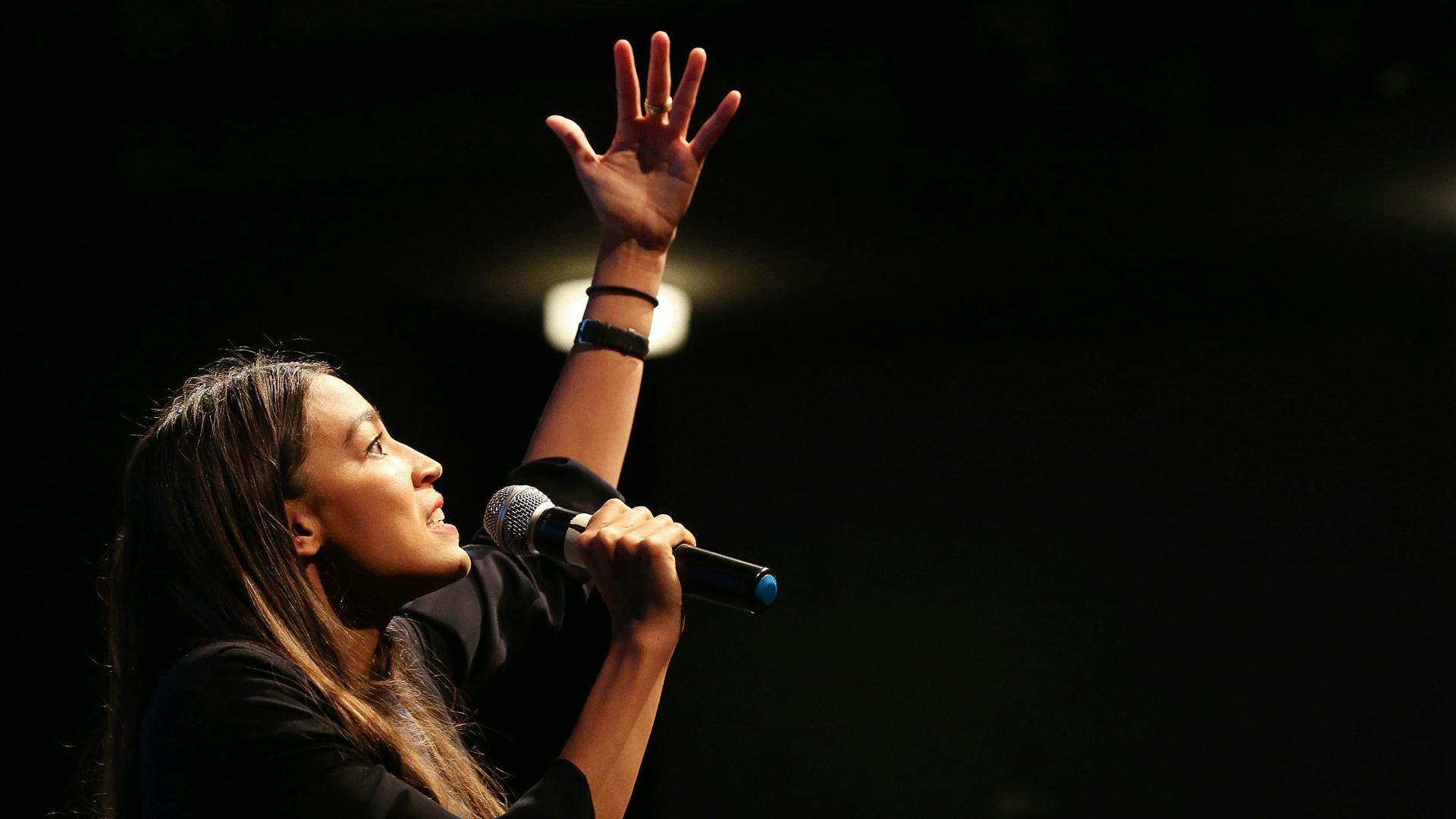TWENTY-EIGHT-YEAR-OLD Alexandria Ocasio-Cortez was just as surprised as anyone by her election victory. On June 26, 2018, Ocasio-Cortez, who had never run for political office before (and whose name was virtually unknown to The New York Times and CNN throughout her entire campaign), beat out long-term incumbent Joseph Crowley in the Democratic primary for New York’s 14th Congressional district, with 57.13 percent of the vote.
Ocasio-Cortez learned of her victory live on air, in a now-iconic segment captured by Spectrum News NY1. In the clip, the on-scene reporter and her team hurry her to camera in the crowded bar where her watch party was being held. The candidate was still en route when the election was officially called in her favor, and having just arrived at the party, she didn’t realize the result until looking at the TVs in the bar. It took a full seven seconds from the moment Ocasio-Cortez first appeared on camera to realize she had won. She gasps and brings her hands to her face.
Should Ocasio-Cortez win the general election in November — a virtual guarantee given the district’s tiny Republican population — she will become the youngest woman in Congress, ever.
THE STORY OF OCASIO-CORTEZ’S VICTORY has all the classic David vs. Goliath tropes. Her campaign spent a mere $194,000, compared to Crowley’s $3.4 million. She received no support from the Democratic Party nor many of its stalwart lobbying groups, while Crowley (per a press release) was supported by “more than two dozen labor groups, Planned Parenthood Action Fund, NARAL Pro-Choice America, Make the Road Action, and the NYS Immigrant Action Fund,” as well as a lot of real estate and banking money.
Social media played a huge role in how Ocasio-Cortez got her message out, given her relative invisibility to the political media. Drawing on her skills as a generational digital native seems natural and even inevitable in retrospect. While it’s unclear if Ocasio-Cortez spent her tween years coding HTML to customize her Myspace profile, she’s a beast when it comes to reaching an audience. At the time of her victory, she had 379,000 followers on Twitter, 127,000 on Instagram, and 88,500 on Facebook, compared to Crowley’s audience of 3,600 on Twitter, 1,400 on Instagram, and 15,000 on Facebook.
But the social media clincher for the Ocasio-Cortez campaign was a video that went staggeringly viral. “The Courage to Change” is a two-minute populist tour de force that has been widely praised for so clearly presenting her platform while authentically depicting her as a woman of the people. The video has all the trappings of a “my story” candidate ad, including the music that slowly builds up to a crescendo before the revelation of her logo and call to action. One of the most humanizing, recognizably New York moments shows her switching from flats into heels while she waits for the subway.
But while it hits all the right notes in a very typical way, this isn’t the product of a marketing agency or a brace of focus groups. Volunteers and a small Detroit production company helped with producing and editing, but Ocasio-Cortez wrote the ad herself, and the people in it are everyday citizens of Queens and the Bronx. As the candidate wrote on Twitter, “One great thing about our campaign video: not a single consultant was involved. I wrote the script. My family is the closing shot. That’s my actual bodega.”
ONE THING THAT SETS OCASIO-CORTEZ apart from most political candidates is that, through the course of her campaign, Ocasio-Cortez was clearly doing most of the actual day-to-day posting to social media. She actually used Twitter to speak directly with the people of her community.
In one Twitter thread about limited parking in the area, users began an intense debate. Ocasio-Cortez joined in the conversation, but once it became apparent she was in over her head, she admitted, “Alright y’all. Obviously this is a heated issue. And I don’t even own a car. Perhaps we do a sit down at my office on federal transportation policy. Open to all & I’m more than willing to learn and grow. That’s the benefit of not taking special interest funds.”
In the middle of the campaign, a Twitter user posted, “Hi there, @Ocasio2018 and @JoeCrowleyNY! I’m a Bronx resident & undecided voter. I’m doing my research and getting informed, but I’d like to hear from both you both. Could you please tell me (in as few/as many tweets as you need) why you deserve my vote? Thank you!”
The manager of Crowley’s account responded with the classic go-private redirect: “Hi Melissa -would love to talk about the Bronx and issues you care about most. Can you DM a # so we can connect?”
Ocasio-Cortez responded, quite publicly, “1. I’m the only candidate who doesn’t take money from corporations. 2. I believe in Medicare for All, Housing as a right, CJ [criminal justice] reform, & tuition-free public college. 3. I’m brave enough to call out corruption in NYC (I also reject luxury developer $). 4. I actually live here.”
That single interaction may tell us a lot about what campaigns from true digital natives will look and sound like in elections to come.






![true [X]](https://images.prismic.io/overtureglobalio/d20d19f0ac141059ec92c667f6cddf6ca09e2c1a_truex-logo2x.png?auto=compress,format)





